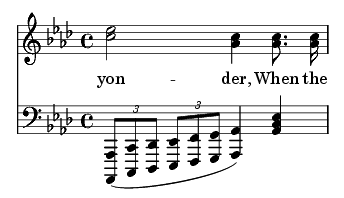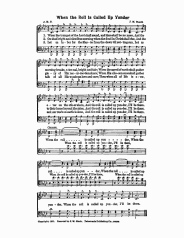If It Is In The Scale, It Probably Works.
When creating a run, it is essential that you have a good grasp of scales. Many classical pianists are well versed in scales, but do not know how or when to apply them. Many church pianists, even if they know how to apply them, stumble when it comes to scale passages. We should seek a balance between the two: The more you know about how to apply scales, the better you should be at playing them. Having a practical working knowledge of scales is the greatest benefit to improvisation; learn scales well, and nothing will be out of your grasp.
Using scales for runs in the evangelistic style are perhaps one of the most impressive musical elements one can produce. The steps involved are as follows:
- Determine where you are trying to put the run.
- Decide on a target note.
- Choose an appropriate rhythm for the run.
- Count how many notes will fit into the run.
- Adjust the starting note so that it is the first note of a chord.
- Make sure it sounds good!
Look at the song When The Roll Is Called Up Yonder. If you wish, you may print out the sample provided below, or you may reference your own hymn book. We will be looking at short runs first, usually lasting only one beat, which occurs in the melody. These small runs are a great introduction to the larger, sweeping runs you will learn later.
If It Is In The Scale: Example 1
Determine where you are trying to put the run.
For the first run, look at the fourth beat of the second measure. Here, the words “And the” provide a good place for a small run, since the melody line is ascending already.

Hymnal Version
Decide on a target note.
The target is the word “morning”, the first beat of the next measure. Therefore, our target note is C.

Target Note
Choose an appropriate rhythm for the run.
The rhythm for the fourth beat (“And the”) is a dotted eighth and sixteenth, giving you two notes on the beat. Now, in the evangelistic style of playing, triplet runs are very common. One could even say that triplets define the evangelistic style. With this in mind, you will incorporate triplets into your run.

Rhythm Desired
Count how many notes will fit into the run.
Since this is a one beat run of triplets, and we already know what the starting note is, we only need to decide what the middle two notes need to be.
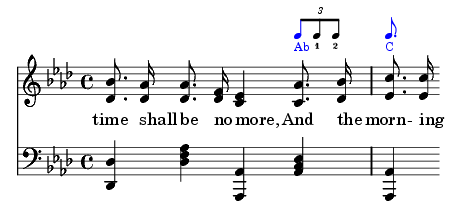
Notes Counted
Adjust the starting note so that it is the first note of a chord.
If you back away from C three scale tones, you will be playing G, Ab, and Bb. This is bad for two reasons. First, G is not part of the Ab chord, which is the underlying chord of the passage. Secondly, the melody note is Ab, so playing a G first will conflict with the melody. You must adjust the run so that Ab is the first of the triplets. This creates a new problem, though, for now you will get to your target note (C) too early. The remedy is to modify the run to include chromatic steps toward the end. In this situation, play Ab, Bb, and B. This will lead you to the C nicely.

Mis-Matched Starting Note

Starting Note Corrected, Target Reached Too Soon

Since you are an observant pianist, you are probably saying, “Wait! B is not in the scale!” This is true, but it is acceptable since it is only played in passing. This will be discussed more in the next section when talking about the third rule.
Make sure it sounds good!
This run sounds best played in octaves, but is not limited to such. Since this is an easier run to implement, you may be tempted to play it too often. Remember: If your ear anticipates hearing this run every time you play through the song, you are probably using it too much.
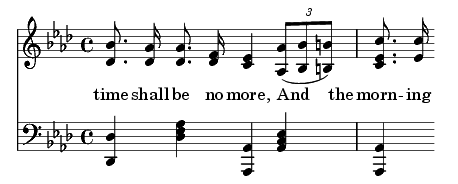
If It Is In The Scale: Example 2
For our second example, we will create a run for a longer passage, using the same principles we used earlier.
Determine where you are trying to put the run.
This run will be placed on the first beat of the fourth measure, at the word “fair”.
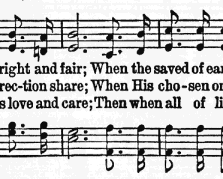
Decide on a target note.
The target note is Ab, the first note of the next phrase, “When the saved of earth…”

Choose an appropriate rhythm for the run.
Again, since triplets are characteristic of the evangelistic style, they will be our rhythm of choice for this run.

Count how many notes will fit into the run.
The word “fair” is held for three beats, and the number of triplets in three beats is 9 (3 x 3 = 9), but this does not mean that you will use 9 triplets in your run. Since the first triplet of the measure is Bb (the melody note), you will probably have to begin your run on the second eighth note triplet of the first beat.
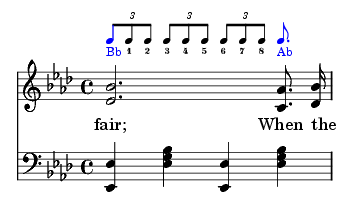
Adjust the starting note so that it is the first note of a chord.
The eight chord tones preceding the target note, Ab, are: G, Ab, Bb, C, Db, Eb, F, and G. Since the underlying chord is Eb, the starting note G will work well for this run.

Make sure it sounds good!
Play this run as it would appear in the music. As is common with runs in the evangelistic style, this would sound better if played on octaves. You can also see that this run can easily push the melody an octave higher, making it a good transition from the basic style of hymn playing into the right hand octave style of playing. Remember to keep the O/C steady as you play!

Put two runs together!
This passage offers a good time to put two shorter runs together to form one long, sweeping run. Use the triplet run you just learned for the first three beats of the measure, then append the one beat triplet run you learned in Example 1 to the fourth beat of the measure. The end result is a four beat run that, when executed cleanly and crisply, convey the majesty and joy of the words, “When the roll is called up yonder, I’ll be there!”
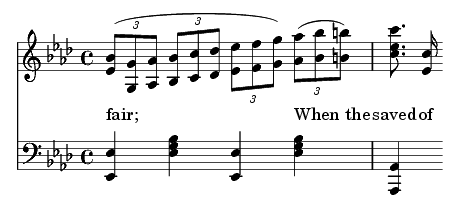
If It Is In The Scale: Example 3
For this third example, you will learn perhaps your most useful run: the one octave triplet run.
Determine where you are trying to put the run.
This run will be placed on the first measure of the chorus, on the word “roll”.

Decide on a target note.
The target note is Eb, on the third beat of the measure. Notice that, in each of the previous runs, the run ended on the next word or note. In this case, however, the run only takes place during the one word, “roll”.

Choose an appropriate rhythm for the run.
Again, the evangelistic style almost demands a triplet run!

Count how many notes will fit into the run.
You only have two beats to complete this run, since the target note is exactly on the third beat. Therefore you have 5 notes to add (the first note of the measure, Eb, is not considered part of the run).

Adjust the starting note so that it is the first note of a chord.
Five scale tones from our target note (Eb) are: G, Ab, Bb, C, and Db. Now the underlying chord for this measure is Ab, which does not blend well with the starting note of the run (G). Therefore, you must move the first note of the run up to Ab. Compensate for this by adding chromatic steps at the end of the end of the run. Now your run should be: Ab, Bb, C, Db, and D. This leads nicely to the Eb of the third beat, an octave higher!


Make sure it sounds good!
As always, the evangelistic style runs sound best in octaves, and work best when playing the right hand in octaves.

If It Is In The Scale: Example 4
Runs are not limited to the right hand, but can be used quite effectively in the bass line as well. In fact, these types of bass runs dominated the playing of Rudy Atwood, a man whose radio presence on the Old Time Revival Hour helped define the evangelistic style. Often, the left hand is considerably less agile than the right hand, so care must be taken not to make the runs sound sloppy. When given proper attention, bass runs not only add an interesting variation to hymn playing, but allow an interesting interplay between the left and right hands.
Determine where you are trying to put the run.
For this example, you will play a bass run in the second measure of the chorus. It appears on the syllable “yon-” (the word “yonder” in the soprano line) and lasts for two beats, ending on “-der”.

I am confident that you understand the concepts we have been using, so I will not waste space illustrating each step along the way. I will, of course, provide the end result at the conclusion of this example.
Decide on a target note.
The target note is Ab, which appears in the bass line, on the third beat (“-der” in the lyrics).
Choose an appropriate rhythm for the run.
What rhythm? Triplets, of course!
Count how many notes will fit into the run.
Five notes will fit between the beginning Ab and the ending Ab an octave higher. They are: C, Db, Eb, F, and G.
Adjust the starting note so that it is the first note of a chord.
Since the starting note (C) is in the underlying chord (Ab), no change needs to be made to the run.
Make sure it sounds good!
This run sounds best in octaves, but should be played without the sustain pedal! Sustain the notes in your right hand by holding down the keys the appropriate two beats, and work with your left hand so that the notes come out distinctly, cleanly, and quickly! Make sure that you do not lose the beat when playing a run in the left hand. Just as with the O/C, keeping a steady beat is your highest priority!
